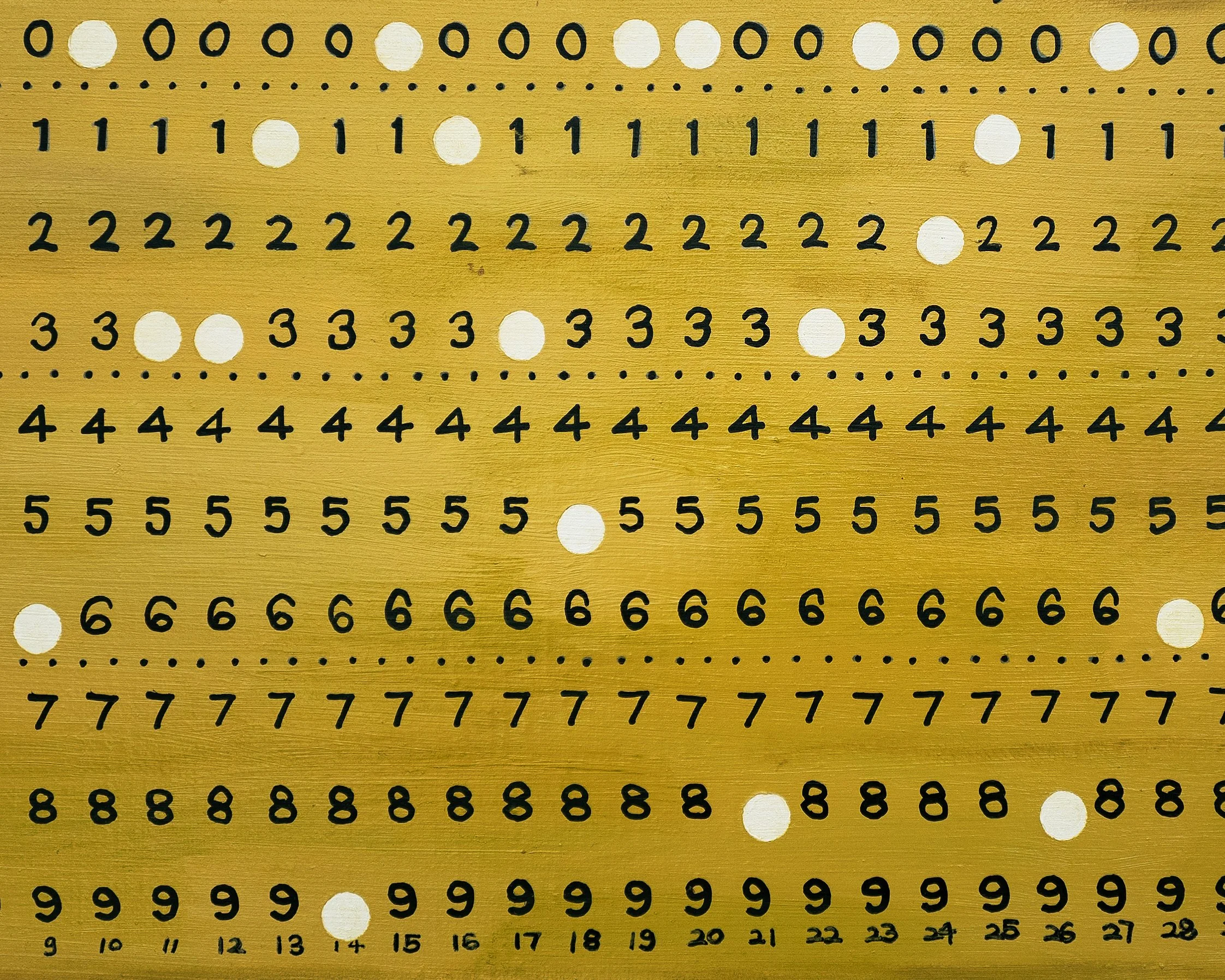Punched card 1, 2022
Punched card 1, 2022
Oil and acrylic medium on linen
30 x 61 cm (12 x 24 in)
A punched card is a stiff paper medium used to store digital data, encoded through the presence or absence of holes in predefined positions. Punched Card 1 (2022) and Punched Card 2 (2022) reinterpret the punched cards widely used in the 1920s, paying homage to an era when these perforated sheets were central to data processing. Throughout the 20th century, punched cards played a crucial role in computing, with the IBM 12-row/80-column format emerging as the dominant standard. Many early digital computers relied on them as the primary method for inputting programs and data, supported by specialized unit record machines that helped organize and process information in early semi-automated data systems. Although punched cards largely became obsolete as a storage medium by 2012, some voting machines still use them today to record ballots. Punched cards embody the origins of human-machine interaction, marking the first instance where information was physically encoded for digital interpretation. As a tangible artifact of computing history, they serve as a bridge between the physical and digital worlds, highlighting the profound transition from early mechanical data storage to today’s intangible digital realm.
Q: How do you perceive the significance of punched cards in the history of computing?
Tan Mu: These works were inspired by early punched cards, a key data input, output, and storage method in the 20th-century computing industry. They were not only fundamental tools for early data storage and processing but also marked the transition from mechanical to electronic computing. Through punched cards, programs and data could be input and output, laying the foundation for later advancements in computer technology. Although this method has long been replaced by more advanced storage systems, its historical significance remains undeniable.
Q: What similarities do you see between punched cards and early human methods of recording information?
Tan Mu: While creating these works, I was reminded of how early humans used knotted cords as a means of recording information. Whether it is the perforations on a punched card or the knots on a string, both rely on physical markings to store and transmit data. This parallel fascinates me because it highlights how, across different technological eras, humans have continually sought ways to encode and preserve information. Punched cards, as an early form of data storage and processing, signify the transition from mechanical to electronic computing. Their resemblance to ancient recording methods makes me reflect on how technological progress has fundamentally transformed the way we understand and process information.
Q: How do you compare punched cards to modern data storage technologies?
Tan Mu: Punched cards allowed computers to process and store information, preserving data for future generations to understand the world as it was. This laid the groundwork for modern computing. The storage method of punched cards was very tangible—one could see and interpret the data through the physical holes and their arrangement. In contrast, today’s storage technologies, such as hard drives and cloud storage, offer vastly greater capacity and speed but operate through increasingly abstract and complex principles. As computing technology continues to evolve, the information we leave for the future may be stored in languages that only machines can comprehend.
Q: Punched Card illustrates an early form of data storage. Does it connect with Memory, your work depicting modern data centers?
Tan Mu: Punched Card is closely related to Memory, as both explore the evolution of data storage technologies—from early punched cards to modern hard drives and cloud computing. The punched card represents a significant historical moment, marking the beginning of structured data storage. These two works are part of my broader exploration of data preservation and technological progress, providing audiences with a reflection on how information has been recorded and processed over time. Punched Card also connects to my work Note G, as both address the role of women in computing history. Whether examining the evolution of data storage or the hidden labor behind it, I seek to document objects and phenomena that have profoundly shaped human history and culture.
Q: You mentioned that punched cards are closely tied to women's labor. Could you elaborate on this?
Tan Mu: Punched cards were not just technological tools—they also reflect the labor-intensive nature of data processing at the time, particularly the crucial role women played in this field. In the early days of data processing, working with punched cards required meticulous, repetitive manual labor. Women dominated this sector, much like factory workers in textile mills. They were responsible for handling large volumes of cards daily, performing data entry and processing. This highly repetitive and physically demanding work was primarily carried out by women, revealing an overlooked yet integral part of computing history.


